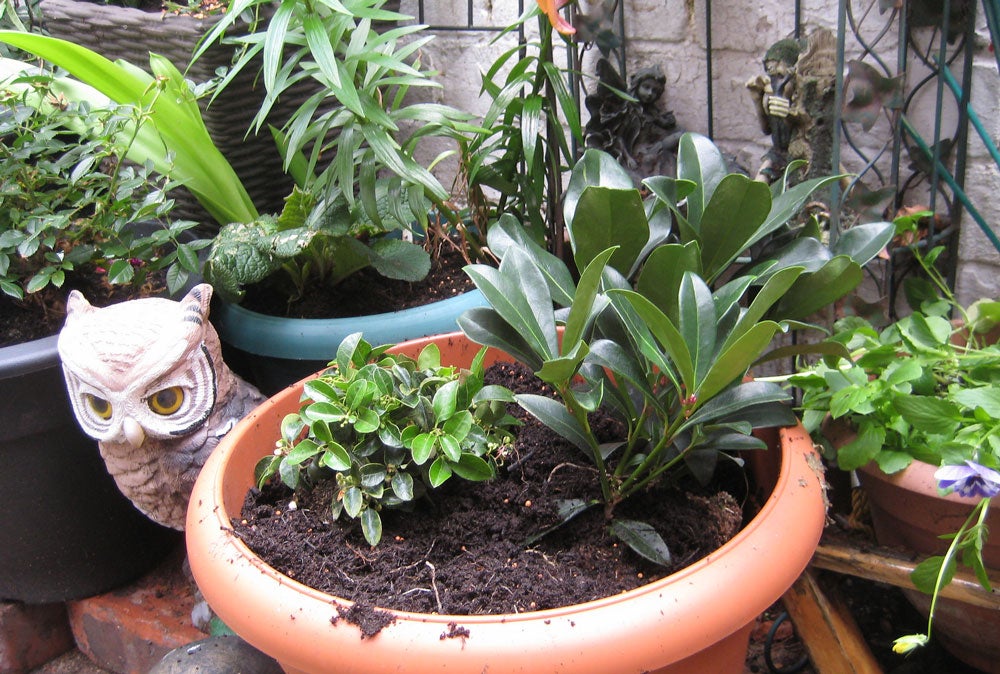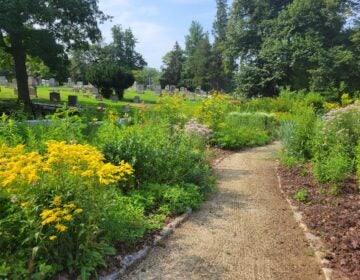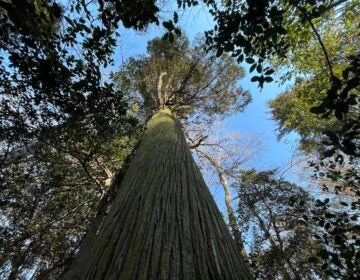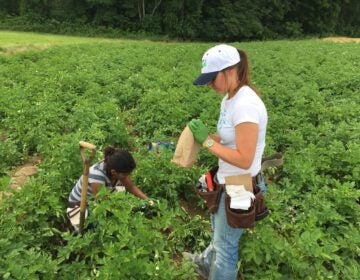How to Keep your Potted Plants Happy in the Cold
Listen 0:52:57Can fruits in pots possibly survive a Chicago winter? Mike McGrath host of You Bet Your Garden will reveal your options for keeping container plants alive in cold climes. Plus: Building soil from the ground up with author Elizabeth Murphy; and your fabulous phone calls.
Photo: madraban via flickr
Question of the Week:
“I planted three blueberry bushes in large containers in my back yard. I know it’s still the height of summer, but I want to have a plan in place to keep them alive over the winter. The way I see it, I can do one of three things: 1) Move the containers to my uninsulated, South-facing, enclosed back porch, which gets good sun, but still gets very cold at night. 2) Build a small “greenhouse” for them out of corrugated plastic. Or 3) Mulch the tops of the containers and not give them another thought until spring. Eek! Do I have a chance? I’ve never tried to keep container plants through the deep freeze!”
— Paul in Chicago, IL
Learn more about protecting blueberries and other potted plants in winter »
Highlights from show:
Troubled Tomatoes
Roberta in Newcastle, DE is upset that her award-winning Jet Star tomatoes aren’t doing well this year. Last year, her troubles began. The lower leaves began to curl, and they got little black dots on the bottom of the leaves, and those leaves would eventually turn rust coloured. Mike immediately identifies the problem: Roberta does not rotate her tomatoes, leading to one of the two common tomato wilts, Verticilium or Fuserium wilt. Tomatoes don’t like growing in the same spot, and in the third year in the same spot, the leaves begin to discolor from the soil up. Now, Roberta has been taking care of this correctly by cutting off the diseased leaves. Mike explains that this is good for two reasons, the first being that the leaves could be spreading disease, and so by cutting the leaves, she’s removing a potential disease vector. The second, and more important reason, is that it makes her look like a better gardener, helping her keep up appearances and make others jealous of her garden. It’s also not a bad idea to have airflow at the bottoms of these plants. Roberta also notes that recently, her grandson built raised beds for her and mixed some of the preexisting soil with Miracle-Gro and spread that along the top and Mike warns her to stay away from potting soil mixed with fertilizers. “If you’re having disease problems, just spread two inches of compost over the surface of your soil. That’ll feed the plants naturally and help prevent disease.”
The Espalier Technique
Jim from Huntington Valley wants to grow an orchard using the espalier method. Now, the espalier technique involves growing a tree in two dimensions, growing it along a trellis. This has been done for several reasons in the past, one of which being to help the tree grow in a colder climate. Attach the tree to a stone wall, the sun beats down upon that stone wall, heating up the stone and keeping the plant warm through the night. Another reason is to grow something up the side of an arbor other than grapes, and make sure that it has good airflow, quite the opposite of the previous reason. Plant the tree at the base of the arbor and as the tree grows, prune it to keep it in two dimensions. You don’t have any branches coming out. Mike asks Jim if he has any experience with fruit trees, and Jim says that he hasn’t, so Mike notes that Jim is making a major commitment here, that growing espalier trees is a heck of a lotta work. Mike asks Jim why he wants to grow in this style, and Jim says that he’d read online that you can get more fruits per square foot, and that he wants to grow a sort of natural fence near his property line. He also likes the benefits of the open airflow. Mike recommends he pick up one of Lee Reich’s books on growing fruits, including his most recent book Growing Fruits Naturally and especially an older book of his called Landscaping with Fruit, which is where he talks the most extensively about espalier. “What you’re describing sounds entirely doable and should be really attractive, especially when the trees are in flower.”
Featured Interview: Elizabeth Murphy
Mike speaks with author Elizabeth Murphy about her new book Building Soil: A Down-to-Earth Approach: Natural Solutions for Better Gardens & Yards. Murphy has been quoted: “A big part of the problem is our fundamental lack of understanding of soils. Not only do we treat them like a non-renewable resource, we treat them like they are inanimate matter. We shovel and scoop and mine and move soils around like the world is our sandbox. This is our downfall. Soils are alive!”
Shady Trees
Eric in Oklahoma City, OK is just moving into a new house and he has a big pecan tree in his backyard and it casts so much shade that nothing can grow. Mike stops him and lets him know that shade is good, and that where he’s at, he needs shade more than most humans. Eric assures him that he wants to keep the tree, but he just wants something that’ll grow well in the shade. Mike recommends he grow St. Augustine grass, which is the most shade-tolerant of all the warm-season grasses. Since it’s a warm-season grass, he should wait until the spring to plant it. Mike also notes that it’s not just the shade of the tree that’s keeping anything from growing, but also the roots of the tree, so he’s going to have to water much more. Mike also recommends that at the base of the tree, instead of growing in the ground, get some boxy planters, put them up on stilts, and then grow shade-loving flowers, like begonias or impatiens to help give his backyard some more colour. “I don’t think you’re going to have any luck growing directly beneath the tree, and if you do, you can interfere with production.”
Too Many Chestnuts
Elana in Lincoln, DE has chestnut trees in her backyard, growing taller than her house. Now she gets thousands of chestnuts every year, and she wants to know what to do with them. Now, they all fall off the trees until they cover her entire backyard. She wants to know when they’re ripe and ready to pick. Mike says that they’re ready the moment they fall off the tree, and they have to be picked up the same day they fall, or else they’ll get moldy. The next step is to cure them. For that, Mike says that if she has a screened-in porch and a ceiling fan, leave them sit under the fan on a table, move them around, rotate them, and then after a week or two, they’ll be ready to store. Mike also recommends that she store them in the freezer because that’ll kill any pests that might be in them, but won’t harm the nuts at all. She has boiled them in the past, and they tasted really good, but she hasn’t gotten to roast them yet and Mike lets her know, “You gotta do that for Christmas!”
Weed and Feed Warnings
Hope from Norman, OK shares a sad tale involving Weed and Feed treatments and small animals. If you have ever looked at the labeling on a package of lawn chemicals, you’ll see a disclaimer: “Keep children and pets out of treated areas until the product has been watered and allowed to dry.” This is why. In Hope’s words, people apply all of these chemicals on their lawns either to get rid of weeds like dandelions or crabgrass, or pests such as moles and voles, but they don’t stop to think about how this affects the critters you want. Not too long ago, Hope’s neighbor had her lawn treated with a generic Weed and Feed product, and later that day, she noticed some kittens from down the way playing in that lawn, as they often do. The next day she looked over there and saw two dead kittens in her neighbor’s driveway, with blood coming from their mouths. Mike notes that this is a sign of a reaction to toxicity, and he gives his rationale on why this could be the case: not only are the kittens nibbling on the grass, which gets a little bit of it into their systems, when they’re in a good mood in a sunny spot, they roll around on the ground, and after they’re all done, they lick themselves clean! “I don’t think you could get more of the pesticide inside of them if you’d fed it to them.” The same is true of dogs: they have soft pads on their feet, and they roll around too, and while they don’t lick their bodies clean, they do lick their paws clean. But he also notes that it’s not even all that necessary to spray your lawn to make it grow. “Grass is one of the most invasive weeds there is. You don’t have to overfertilize it, you don’t have to herbicide it. You just need to cut it at the right height and leave the clippings on the lawn.” Hope also notes, to close, that after this event, her neighbors threw out the bag of lawn chemicals and were out there working hard to get rid of the chemicals. “I think they really did care, they just weren’t aware.”
WHYY is your source for fact-based, in-depth journalism and information. As a nonprofit organization, we rely on financial support from readers like you. Please give today.





